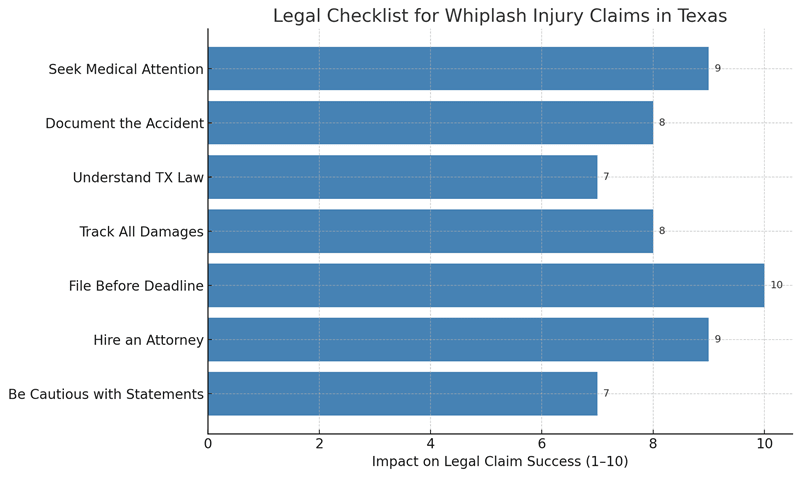Whiplash is one of the most common injuries in Texas car accidents, especially rear-end collisions, but it’s also one of the most misunderstood. Often dismissed as “minor,” whiplash can lead to long-term neck pain, migraines, and even spinal damage. If you’ve been in a crash and suspect whiplash, knowing what to do next is crucial.
This 7-step checklist from Eric Ramos Law, PLLC will help you protect your rights, avoid insurance pitfalls, and seek the compensation you deserve under Texas law.
1. Seek Immediate Medical Attention
Whiplash symptoms may not appear for hours or even days after an accident. You may feel fine at first, but later develop:
- Neck stiffness or reduced range of motion
- Headaches or dizziness
- Shoulder or upper back pain
- Tingling in arms or hands
Prompt medical treatment not only protects your health but also establishes a medical record linking your injury to the accident.
If you were in a rear-end collision or a passenger in a car accident, seek care right away, even if symptoms are mild.
2. Document the Accident Scene and Injury
The stronger your documentation, the stronger your legal case. Preserve all evidence from the crash:
- Photos of the vehicles, damage, and the scene
- Police report and incident number
- Names and contact info of witnesses
- Timeline of your symptoms
Also, keep copies of medical bills, diagnoses, and prescribed treatment. These details are essential if your whiplash injury leads to a personal injury claim.
3. Understand How Texas Law Impacts Your Case
Texas is a “fault” state, meaning the party responsible for the accident is liable for damages. But Texas also applies modified comparative negligence. If you’re found more than 50% at fault, you can’t recover damages. If you’re 20% at fault, your compensation is reduced by 20%.
This rule plays a big role in motorcycle accidents and truck accidents where insurers try to shift blame to minimize payouts.
4. Track Both Economic and Non-Economic Losses
Whiplash injuries are typically classified as soft tissue damage, which insurance companies love to downplay. But their impact can be serious, and compensable.
Document both:
- Economic losses: ER visits, chiropractic care, physical therapy, lost wages, travel expenses
- Non-economic damages: Pain and suffering, anxiety, sleep issues, diminished quality of life
If your condition prevents you from returning to work, our firm can help calculate your long-term lost earning capacity.
5. Don’t Miss the Statute of Limitations
In Texas, you typically have two years from the date of the accident to file a personal injury lawsuit. Waiting too long can bar your case, even if your injuries are severe.
Some exceptions exist (such as injuries to minors), but don’t rely on them. Contacting an attorney early is the safest path forward.
If your injury occurred during a rideshare accident or a workplace incident, there may be additional legal requirements and timelines.
6. Hire a Whiplash Injury Attorney Who Knows Texas Law
Insurance adjusters often undervalue whiplash cases or deny them outright. They may claim:
- There wasn’t enough vehicle damage to justify your injury
- You had a pre-existing condition
- You’re exaggerating your symptoms
That’s why it’s essential to hire an experienced attorney who understands Texas injury law—and who can push back on bad faith insurance tactics.
At Eric Ramos Law, we’ve handled countless soft tissue injury claims, including whiplash stemming from slip and fall accidents and pedestrian incidents. We prepare every case as if it’s going to trial to maximize leverage in settlement negotiations.
7. Be Careful What You Say and Share
After an accident, what you say to insurers or online can be used against you. Follow these rules:
- Don’t post about your accident or injury on social media
- Don’t downplay your symptoms to adjusters or doctors
- Don’t sign anything without a legal review
- Keep a personal injury journal to track symptoms and their impact
Even a casual comment like “I’m feeling better today” can be misused to minimize your claim. Our legal team helps clients avoid these traps from Day One.
Legal Checklist for Whiplash Injury Claims in Texas
Frequently Asked Questions About Whiplash Injuries
Is whiplash a serious injury under Texas law?
Yes. While often misunderstood, whiplash can result in long-term neck and spinal issues. It qualifies as a compensable injury under Texas personal injury statutes.
How much is a typical whiplash case worth in Texas?
There’s no fixed amount. Settlements range from a few thousand to six figures, depending on medical costs, severity, time off work, and whether the injury leads to lasting impairment.
Do I need a lawyer for a minor whiplash injury?
If symptoms persist, treatment becomes costly, or fault is disputed, hiring a lawyer improves your chances of full recovery. Even so-called “minor” injuries can have major consequences.
Related Services and Resources
Eric Ramos Law handles a wide range of accident claims across Texas. You may also be interested in:
- Spinal Cord Injury Claims
- Bicycle Accident Injuries
- Dog Bite Injury Cases
- Medical Malpractice
- Wrongful Death Claims
Final Thoughts: Don’t Let a Whiplash Injury Derail Your Life
Whiplash injuries may be “invisible” on X-rays—but their physical and emotional impact can be real, painful, and expensive. Following this 7-step legal checklist can make the difference between a denied claim and a fair settlement.
At Eric Ramos Law, PLLC, we’re committed to standing up for injury victims in San Antonio and across Texas. From rear-end crashes to workplace trauma, we help clients get the medical treatment, legal protection, and financial compensation they need to heal and move forward.
Call (210) 404-4878 or visit ericramoslaw.com today to schedule your free, no-obligation consultation.
